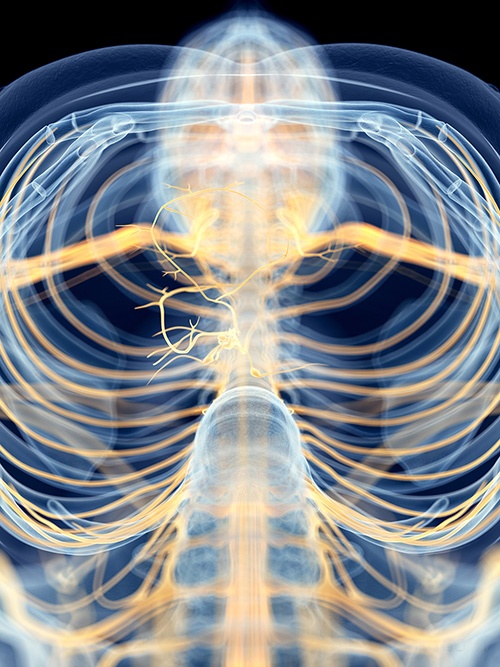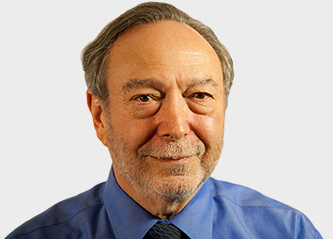Polyvagal Theory and Trauma
with Stephen Porges, PhD and Ruth Buczynski, PhD
Polyvagal Theory can play a critical role in helping us map, track and re-pattern the nervous systems of clients who have experienced trauma. So how can we approach trauma treatment from a polyvagal perspective?
What happens when a client’s fight/flight response fails? Consider this short example.
On CNN they showed an airplane having difficulty landing. The wings were tipping back and forth and the outcome was uncertain.
After it landed, a reporter interviewed the passengers, going up to one woman and asking, “How did you feel?”
She said, “Feel? I passed out.”
Was the woman’s passing out a voluntary escape? No, her nervous system detected features of risk.
You see, our neuroception – our nervous system’s evaluation of risk – is functionally unpredictable (and it happens without our awareness). We don’t know how our nervous system will respond.
If that plane hit the ground and went up into flames, her transition from life to death would have been without pain. However, there were other passengers who were screaming, and some who were relatively calm.
So here we have an example of the same scary event being translated by different nervous systems in different ways.

Why Does the Nervous System’s Response Matter?
The nervous system’s response to a traumatic experience can provide valuable information about how to move forward with treatment.
So, just for a moment, let’s back up and review the development of the vagus nerve.
Early in vertebrate evolution, neural regulation of the heart was mediated by an unmyelinated, less-than-efficient vagus. This neural system provided an ability to defend by immobilizing, which meant reducing metabolic demands, reducing oxygen demands, reducing food demands, and surviving.
As mammals evolved, something special happened to the vagus. The evolved, myelinated vagus was able to dampen the sympathetic nervous system and the adrenal circuits to enable mammals to both engage socially and optimize metabolic resources.
This is one of the main points of the Polyvagal Theory[1] – when we are social and engaged, we’re reducing metabolic demands in order to facilitate health, growth, and restoration.
So, you can begin to see why the therapeutic relationship is so essential to helping clients heal.
Trauma often disrupts a client’s source of social support, leaving them with fewer options to remain regulated.
But with the social support that clients receive in therapy, they can begin to once again regulate their autonomic state.
How the Nervous System Responds to Trauma
The nervous system has three autonomic responses to stress and trauma that follow an evolutionary hierarchy.
So, according to Polyvagal Theory, we rely on the newest responses to help us return to a state of safety. But when the newer responses fail, we regress to using older evolutionary responses.
It’s this hierarchy that can give us (and clients) a profound window into understanding a trauma response.
So let’s say a client is confronted with a challenge. How will their nervous system respond?
- Social Engagement System – The first circuit of their nervous system – the pathway that is unique to mammals – will try to negotiate by using the face, vocalization, or language. This is what Stephen Porges, PhD has coined the social engagement system.
- Sympathetic Nervous System – If the social engagement system doesn’t negate the threat, that latest circuit will retract in order to promote mobilization. This is when the client’s sympathetic nervous system will gear up for fight or flight.
- Parasympathetic Immobilization – If fight/flight doesn’t work and the threat persists, the client’s nervous system will resort to its oldest and most primitive response: parasympathetic immobilization. According to Stephen, this action is controlled by the old vagus that we share with reptiles.
Think back to our earlier example of the woman who passed out. Being trapped on the plane, she had no way to escape the danger and fighting certainly wouldn’t have made a difference.
In that circumstance, her nervous system evaluated the risk of threat, realized that mobilization wouldn’t be an effective defense, and concluded that it wouldn’t make sense to continue increasing sympathetic nervous system activity.
Instead, her nervous system decided to trigger a shutdown response.
This is probably similar to other responses you’ve heard described by clients with trauma histories, especially small children, people confronted by others who are larger and stronger, or experiences in an environment where someone has a weapon.
The problem is that when we start dealing with trauma, the clinical world is obsessed with the event and not with understanding that a person’s response to the event is the critical feature.
Trauma’s Lasting Impact on the Nervous System
When clients experience trauma, their nervous systems often remain on high alert for any sign of danger. This puts them at a higher risk of slipping back into sympathetic mobilization or parasympathetic immobilization.
And when clients go into a state of immobilization with fear, the nervous system doesn’t provide them with an easy way to get back to a regulated state where social engagement processes are easily recruited.
Let’s go back to our example of the woman on the plane.
It’s likely that her plane’s near crash will keep her from flying anytime soon – and for good reason. But now, there could also be non-threatening experiences that trigger her response.
A bumpy car ride might produce a sensation like the turbulence the plane flew through. Perhaps the low frequency of someone’s voice is similar to the hum of the plane’s engines.
Now, in her heightened state of alertness, the woman doesn’t make these connections. All she’s aware of is how her body is reacting, and she’s trying to figure out why.
For most clients, their trauma experience results in the development of a complex narrative that attempts to make sense of what their body is experiencing.
These narratives, while often irrational, can explain why clients who have experienced trauma don’t want to socially interact.
Let’s say the woman from our example is a passenger in a car and is triggered by a bumpy ride. Now, the driver is not at all at fault for the condition of the road, but she’s likely going to say, “He’s a bad driver,” and will use that narrative as an excuse to avoid going places with him.
Or perhaps she has a friend who is loud and has a low-frequency voice. Before her traumatic experience, she was never bothered by his voice. But now, his voice is giving her cues of danger. And instead of recognizing why, she comes up with more and more reasons for why she doesn’t like this friend as much anymore.
This is why clients who experience trauma often distance themselves from others.
They’re exhausted, their nervous system is detecting risk when there is no real risk, and they are trying to negotiate this very complex world. The narrative they’re building is an attempt to support the physiological experience, but it’s also part of the reason why they have trouble connecting. And it’s also why a client’s trauma story is not nearly as important as their response.
Polyvagal Theory in Clinical Practice
So how can Polyvagal Theory enhance clinical practice?
There are several Polyvagal-informed strategies that can help recruit the social engagement system and shift clients out of a dangerous immobilization state.

- Remove Cues of Danger – The first step is to remove any potential cues of danger. It’s important to remember that every client’s nervous system responds differently to different cues, but there are few things you can focus on. Get rid of any loud, low-frequency sounds because those sounds can trigger our nervous systems to think that a predator might be nearby. Instead, opt for a quiet clinical setting to start.
- Increase Cues of Safety – The next thing that the therapist needs to do is use the space to ensure safety. Stephen, Pat Ogden, PhD, Peter Levine, PhD, and Ruth Lanius, MD, PhD are truly masters in understanding this feature. In Pat’s clinical settings, she empowers the client to navigate the space in her office to promote choice and ensure a sense of safety. But feeling safe also has a lot to do with the proximity of the therapist. In a sense, the therapist, as another human being, is dangerous to a client who has been traumatized. So Peter pays very close attention to how both he and his furniture are arranged in his office. Ruth takes a strengths inventory to help uncover and better work with her client’s strengths. Finally, according to Stephen, soft vocal music can help calm the nervous system and begin to stimulate the social engagement system.All of these techniques can help increase a client’s sense of safety.
- Re-Enlist the Social Engagement System – Once the client has a feeling of safety, there will likely be a shift in their physiological state. This is when their spontaneous engagement behaviors occur, including a change in tone of voice and facial expressions. If the therapist is reciprocal and responds with engagement behaviors characterized by prosodic voice and positive facial affect, the client’s social engagement system will be stimulated.
The Polyvagal Theory can transform how we think about working with patients who have experienced trauma. Because once you know how trauma is impacting your patient’s nervous system, you can adapt your interventions to be faster and more effective.
And remember. . .
. . . when you help someone heal from trauma, you can change the course of civilization. That’s because it’s not just that person’s life that changes, but that healing can also have an impact on their spouse, their children, and their friends and colleagues. And that can ripple out to their community, to their state and then to their country, and eventually to the world. What you do is so important.
References

About Stephen Porges, PhD:
Developer of Polyvagal Theory; Distinguished University Scientist at the Kinsey Institute at Indiana University Bloomington and Research Professor in the Department of Psychiatry at University of North Carolina Chapel Hill
Want more ideas and strategies you can use with your clients today?
Check out a course featuring Stephen Porges, PhD:

Why the Vagal System Holds the Key to the Treatment of Trauma
2 CE/CME Credits Available

The Treating Trauma Master Series
10 CE/CME Credits Available

Working with the Pain of Abandonment
4.25 CE/CME Credits Available

How to Work With Shame
4 CE/CME Credits Available